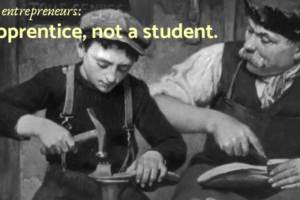How to apply Buddha’s wisdom in the 21st century
Perhaps in Buddha’s time it made sense to identify your calling “and then, with all your heart, give yourself to it.” And as the quote implies, expect to spend the rest of your life at that pursuit.
Buddha’s blunder?
I’m not that old, so I can’t be sure if it was true in Buddha’s world, but I know that lifelong careers or jobs are pretty rare nowadays.
According to a U.S. Bureau of Labor Statistics report in 2015, the sample of “younger baby boomers” they followed had “held an average of 11.7 jobs from ages 18 to 48.” Stopping counting jobs at age 48 seems a bit unrealistic – maybe the researchers wanted to get something published after tracking their sample for 30 years! So I think it’s safe to project a significantly higher total number of jobs held over our full working lives.
Now, the BLS researchers caution that they do not provide statistics on career changes, citing a lack of consensus on what it means to change careers vs. changing jobs. However, some data has been collected. In a 2007 NY Times article, Marci Alboher cited an NYU survey of professionals reporting they expected to change careers an average of three times. That would mean an average of four careers over their lifetimes, right?
More recently, a 2013 University of Phoenix survey found that:
Nearly 80 percent of workers in their 20s said they wanted to change careers, followed by 64 percent of 30-somethings and 54 percent in their 40s.
If you’ve read my 100 + Life Manifesto or read the Elderships post, you won’t be surprised that I find these reports focusing on work and career goals solely for people in their 40s or less . . . shall I say, amusing, at best. Those folks haven’t even worked – let alone lived – for half of their probable spans!
Don’t believe me? Ya gotta go play with this cool animated life span probability tool at FlowingData.com. Using Social Security actuarial table data, here’s what the tool shows for a 40 year old female (the longer you let the tool run, the more it will start to skew slightly toward longer results):

For the researchers and 40-year-olds out there thinking – or living as if – their work will be done at age 50, I pass on this advice:
Here is a test to find out whether your mission in life is complete. If you’re alive, it isn’t.
— Lauren Bacall
But we were talking about multiple jobs, careers, “missions” here. So let’s get back to why I think both Buddha and Bacall erred in talking about work or mission in the singular.
Living Multi-stage AND Multi-faceted Lives
Aside from the doubling of our life spans in just the last century, in announcing the University of Phoenix results above, university president Dr. Bill Pepicello said,
Choosing one career path after high school or college and sticking with it for the rest of a career is becoming less common as the pace of business and technology quickly change jobs and industries.
And quite apart from the external forces of human longevity and the pace of change, our internal landscape changes, too.
As we age, we’re learning, growing, maturing. Our capacities for pursuing particular kinds of work change, too, some improving, others diminishing. Not only are we changing over time in what we can do, but also in what we want to do.
Two pages after citing the Buddha quote, Halley Bock put it this way in her book, Life, Incorporated: A Practical Guide to Wholehearted Living (her emphasis):
We have got to get out of this mindset that what we were fired up about in our college years will remain our passion for the entirety of our lives. . . . We change everything in our world at a breakneck pace, from the societal to the individual level.
It’s no wonder that the 2015 follow-up survey by the University of Phoenix found that “Approximately 60 percent of all working adults want a new career.” Nice to see them include “all working adults” this time!
Note my bold-italic emphasis of the phrase “all working adults want a new career.” With a slight modification, I think it correctly captures the combined impact of:
- increasing human longevity,
- increasing pace of change in every aspect of work, and
- our own human propensity for curiosity, creativity, and novelty.
I’d restate the finding as: All working adults will want career change, sooner or later, probably more than once.
That line of reasoning suggests we should expect multiple careers in more or less sequential chronological stages of our lives. This doesn’t give us a chance to apply Buddha’s wisdom at all. Indeed, British authors Lynda Gratton and Andrew Scott describe career scenarios with 3, 4, and even 5 distinct stages, in their new book, The 100-year Life: Living and Working in an Age of Longevity.
Just as important, though, we need to recognize that our lives include multiple facets besides our work, when we’re using “work” to refer to our vocation. Halley Bock defines vocation as what we do to provide “a necessary source of income.”
The moment we bring our discussion of work down from the mountain top of “discovering” ours into the day-to-day reality of earning enough money to support our lifestyles, things get a bit more complicated, eh? We need to account for time spent on the other facets of our lives: our physical, intellectual, emotional, relational, and spiritual wellness. (These facets correspond to my PIERS Whole-Self Model, covered in our course, 5 Steps to Ageless: Applying the New Science for Aging Well Through Life’s Transitions.)
Sure, life is messy. Maybe messier now than in Buddha’s time. We need to face our longer lifespans and the likelihood of wanting or being forced by external changes to give ourselves whole-heartedly to our work more than once. And that doing so should not exclude ongoing attention to the other facets of our lives.
I’m not at all saying that Buddha’s advice is wrong. It’s an inspiring view of how we should approach work as vocation. Even in his time, more than two millennia ago, Buddha taught there is much more to living than “your work.” Just one example, with echoes in my PIERS model:
Health is the greatest gift, contentment the greatest wealth, faithfulness the best relationship.
— Buddha (via Brainy Quotes)
I am saying that in our current times, the multiple stages and facets of our lives overlap and interact. We need to address the needs of our multi-stage and multi-faceted lives consciously and continuously.
So, what should we be doing to apply Buddha’s wisdom and channel Bacall in our present-day lives?
![A quote from Arnim Rodeck that reads "[My father] would always say that when you become good at what you do, it's time to change. 'Don't wait for what comes after that.' He meant, don't wait until you're tired of it." The image is attached to a post on how to apply Buddha's wisdom in the 21st century.](https://i0.wp.com/masterbookbuilders.com/wp-content/uploads/2023/12/Arnim-Rodek-quote.png?resize=1024%2C1024&ssl=1)
Re-applying Buddha’s wisdom
As the opening image shows, follow your dog’s lead. Okay, I’m just trying to get you to look at the image again.
Sort of.
The dog in the photo is looking right, hopefully calling your attention to my Buddha-rule corollary:
And then, when you discover that it is no longer your work . . .
Rinse.
Repeat.
In simplest terms, that’s how I think we need to apply Buddha’s advice in our lives. Always be attuned to how your work makes you feel. When you no longer find sufficient meaning in it, get about the work of discovering “your work” again.
And don’t be surprised if the “rinse” step – getting rid of baggage about “quitting” or expectations (yours or others’) about what you should be doing – proves challenging, but essential.
Step 1. Begin by acknowledging that the work you’ve chosen and given yourself to will not likely remain your work for the rest of your life – which is why we’ve spent to much time laying out that case. Becoming aware of your internal responses to what you are doing and opening yourself to new opportunities for a more fulfilling path is the first step.
How will you know the time is right for changing career paths? One of the many case studies Barbara Oakley offers in Mindshift: Break Through Obstacles to Learning and Discover Your Hidden Potential, tells the story of Arnim Rodeck’s journey from engineer to woodworker. Oakley relates this advice he heard from his father:
He would always say that when you become good at what you do, it’s time to change. ‘Don’t wait for what comes after that.’ He meant, don’t wait until you’re tired of it.
Although I have not been able to find it online, I remember reading a print magazine interview with Robert Redford years ago, where he offered a very similar rule to explain his refocus from acting to the Sundance Institute. As I recall it, he said something like, whenever you get comfortable in your work, do something else; start over from zero.
Step 2. Next, if we expect that change will be coming sooner or later, it only makes sense to take ongoing action to be prepared, right? Another one of Oakley’s case studies advocates “Second-Skilling” – drawing from a government supported formal program in Singapore that helps all workers develop a second set of marketable skills that prepares them for changes in their industry or the economy.
The “side hustle” concept from Chris Guillebeau’s books provides a more hands-on approach to “digging the well before you need the water.” A side hustle or side project involves working at a part-time job or starting a business that generates income and allows you to run relatively quick and low-risk tests of how well you fit with new possibilities you identify.
In addition to those mentioned above, further examples and guidance can be found in books (and the authors’ websites) such as:
- Working Identity: Unconventional Strategies for Reinventing Your Career, by Herminia Ibarra
- Getting Unstuck: How Dead Ends Become New Paths, by Timothy Butler
- It’s Never Too Late to Begin Again: Discovering Creativity and Meaning at Midlife and Beyond, by Julia Cameron and Emma Lively
Step 3. Finally, if you find that you’ve already hit a wall (what Timothy Butler calls an “impasse” and Herminia Ibarra describes as being frozen), or been hit with one you didn’t see coming, remember #21 in The 100 + Life Manifesto:
Never stay stuck. If you’re not getting free on your own, ask for help.
As the sidebar note explains: Think of it like being stuck in mud or snow with your car. Or maybe the car stalls and won’t start.
Sometimes you can rock the car forward and back and get yourself free; or maybe pop the hood, clean the battery cable connectors, and the engine rolls over and starts. Sometimes friends or bystanders can push you out, or give you a jump-start. But sometimes you need to call a tow truck or roadside mechanic to get moving again.
The same logic applies when you’re feeling stuck in your work or personal life. You may find the key to getting free by reading a book or blog post. Advice or nudges from friends or family may help.
But other times, you need to hire a coach or mentor to help identify the true problem, find your next path, and get you moving again (as I like to say) “with confidence and joy!”
Just don’t stay stuck. Remember, if you’re alive, your missions aren’t complete . . . even if you have to work to discover your next one.






Leave a Reply